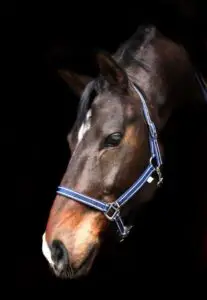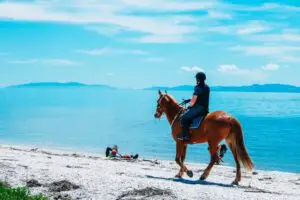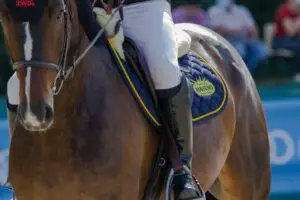If you have ever wondered why anyone would need endurance for horse riding, just think of how long a typical horse ride takes. Horse rides could take anywhere from a few minutes to hours. The longer you ride the more endurance you and your horse need to make it happen.
Endurance riding can basically be described as an activity that usually takes place in areas like the countryside where there aren’t a lot of people. The event can take more than the entire day depending on the distance to be covered.
Endurance riding is an amazing competition for equestrians. You have the opportunity to ride for hours and your performance is not determined solely on whether you finish first or not.

For most endurance riders winning simply means completing the race with your horse.
You will get an award for finishing the ride. It is a challenge for you as well as your horse and the outcome depends on how you both perform. It’s also a fun communal activity for equestrians.
Perhaps you are wondering how to learn endurance as a rider. Well, you’ve come to the right place. You can totally enter the next endurance riding competition if you follow the tips that will be provided in this article.
Keep Fit
Regardless of whether horse riding is a hobby or a professional sport for you, you need to be fit to gain endurance while riding. While riding might just seem like sitting on a horse, it is way more than that.
Your upper body strength, arms, and legs play a significant role in how you ride.
Riding your horse is a way to keep fit and practice in itself, but it doesn’t hurt to do more outside the trails. There are exercises that can teach you endurance as well as improve your upper body strength.

You can’t go for horse riding without a horse and if you’re going for an endurance ride or competition (or any kind of ride really), the fitness of your horse is an important factor to consider.
A properly trained, healthy horse should be your choicest companion for an endurance ride. Take a horse who’s regularly taken out for rides, such horses are fit for endurance rides compared to those who rarely leave the stables.
Of course, you can start training an inactive horse in preparation for its first endurance ride, but that could take months. Ride at a walk, trot, and a bit of cantering for about an hour at a time.
Learn About Endurance Riding
The best way to get started on endurance riding is by learning what it entails. It isn’t wise to venture into an activity without having sufficient knowledge about it.
The American Endurance Ride Conference (AERC) is a well-regulated endurance riding event.
Volunteering at such an event will equip your knowledge bank on how to excel in the sport. You will have a first-hand observation of what goes on during an endurance ride, including the role veterinarians play to ensure the horses are in a healthy condition during and after the ride.
The safety of the horse during the event is of utmost concern to the veterinarians, so riders make some stops for vet checks.
There are three horse rides approved by the AERC, the 25-mile distance is the shortest, and the riders are given 6 hours to complete it. 12 hours is attributed for a 50-mile ride and 24 hours for a tasking 100-mile ride.
AERC events take place in different parts of the country; you can visit the AERC website to learn about the event closest to you.
Find The Perfect Horse
Arabian breeds are known to dominate long-distance endurance rides but don’t be distraught if your horse is a different breed. More focus should be geared towards the physical state of your riding companion.
You will find a variety of breeds at endurance rides, from Tennessee Walkers to mules. The breed of your horse shouldn’t matter and neither should its size.

Horses perform better at endurance rides the older they get, from their mid-teens to their early thirties; they are as strong as they can ever be. Some riders use the same horse in this competition for an average of 15 years.
Find The Right Tack
For a long ride, the benefits of having a perfectly-fitting tack cannot be overlooked. Before going for an endurance ride, ensure you get the perfect tack for your horse.
There a variety of saddles to choose from for a long-distance ride, we have the treeless, paneled, English, Australian, and others. Regardless of the type, you decide to go for, ensure you invest in a saddle of good quality.
The surface area should also be large enough to keep both you and your riding companion comfortable.
Go For A Ride
You’re not going to learn endurance if you don’t go for an actual endurance ride. Start off with the 25-mile ride. After you’ve learned all you need to about endurance riding, gotten a fit and properly trained horse with the perfect tack, you can go for an endurance ride event.
I recommend you start with the shortest distance.
Prior to the event, your horse will need to undergo a pre-ride health check which it must pass to qualify you for the ride.
There’s no need to be shy, inform the manager and veterinarians that this is your first endurance ride. In addition to the general meeting where everyone gets a map, there’ll be a special meeting for first-timers where the entire procedure will be explained in detail.
It will help not to view the event as a competition, but as an opportunity to improve your endurance and learn with experience, your goal should be to complete the race. Ensure you enjoy your time, do not be nervous.
Vet Checks
Veterinarian checks are an important part of the event. The purpose of these checks is to ensure the horse remains in a healthy condition during the entire event.
If a problem is detected, the horse gets disqualified from the race. These checks take place, before, during, and after the ride. Bear in mind that the veterinarians are there to ensure the safety of your horse.

The exact time you get to a vet check is recorded, after which you’ll have to wait through a hold time of 15, 20, 30, or 60 minutes. You will able to continue your ride once the hold time you were given elapses.
The hold time does not begin immediately you arrive at the vet check. It begins when your horse’s heart rate comes down to about 60 bpm. The veterinarian also checks the horse’s locomotion, dehydration, attitude, gut sounds, and for any injuries.
If your horse is fit, the process will pass really quickly and you’ll get back on the trail. According to AERC rules, any horse that takes more than 30 minutes to get the desired heart rate gets disqualified.
Ensure you follow all the protocols from the start to finish. Even after completion of the ride, check with the veterinarian before you leave the camp.
Final Thoughts on Gaining Endurance For Horse Riding
Going for endurance rides demands that both you and your horse are in a fit condition. This translates to being a frequent rider. Ride, ride, and ride some more while obeying all the rules put in place to ensure the safety of the horse.

